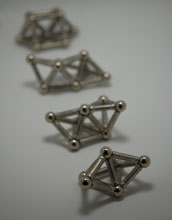Multimedia Gallery
Entropy Made Visible
The magnetic stick and ball constructed toys first used to understand entropy, the number of different ways in which particles are able to arrange themselves.
Scientists have long studied how atoms and molecules structure themselves into intricate clusters, but researchers from Harvard University discovered additional clues as to how and why groups of atoms and molecules may favor less symmetrical and more complex, flexible geometric patterns. To read more about this research, see the story "Learning From Toys" in Harvard's daily on-line newsletter, the Harvard Gazette. [Research supported in part by a grant from the National Science Foundation.] (Date of Image: January 2010) [See related image Here.]
Credit: Vinothan Manoharan, School of Engineering and Applied Sciences
Images and other media in the National Science Foundation Multimedia Gallery are available for use in print and electronic material by NSF employees, members of the media, university staff, teachers and the general public. All media in the gallery are intended for personal, educational and nonprofit/non-commercial use only.
Images credited to the National Science Foundation, a federal agency, are in the public domain. The images were created by employees of the United States Government as part of their official duties or prepared by contractors as "works for hire" for NSF. You may freely use NSF-credited images and, at your discretion, credit NSF with a "Courtesy: National Science Foundation" notation.
Additional information about general usage can be found in Conditions.
Also Available:
Download the high-resolution JPG version of the image. (970 KB)
Use your mouse to right-click (Mac users may need to Ctrl-click) the link above and choose the option that will save the file or target to your computer.



